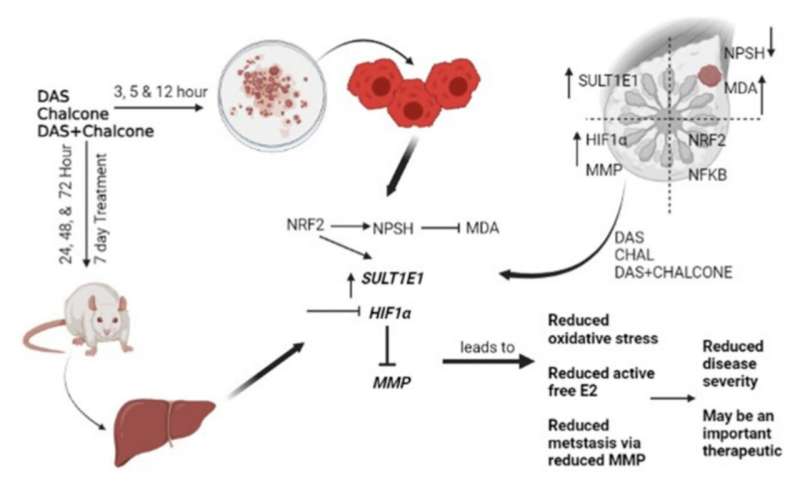This article has been reviewed according to Science X's editorial process and policies. Editors have highlighted the following attributes while ensuring the content's credibility:
fact-checked
proofread
Study: Dialyl-sulfide and trans-chalcone prevent breast cancer by targeting SULT1E1 and HIF1a-MMPs

A new research paper was published inGenes & Cancer on August 9, 2024, titled "Dialyl-sulfide with trans-chalcone prevent breast cancer prohibiting SULT1E1 malregulations and oxidant-stress induced HIF1a-MMPs induction."
In some breast cancers, altered estrogen-sulfotransferase (SULT1E1) and its inactivation by oxidative stress lead to modified E2 levels. Simultaneously, hypoxia-inducible tissue-damaging factors (HIF1α) are induced. The expression of these proteins/genes was verified in human breast cancer tissues, and combinations of SULT1E1-inducing drugs were tested for their potential protective effects.
In this study, the oxidative stress neutralizer chalcone (trans-1,3-diaryl-2-propen-1-ones) and the SULT1E1 inducer pure diallyl sulfide (from garlic, Allium sativum) were tested in both in-vitro and in-vivo rat models to prevent cancer-related changes.
In their research paper, researchers Aarifa Nazmeen, Sayantani Maiti and Smarajit Maiti from Oriental Institute of Science and Technology, Haldia Institute of Health Sciences, and AgriCure Biotech Research Society in Midnapore, India, reveal for the first time that advanced cancer tissues with elevated SULT1E1 protein levels may be reactivated in a reducing environment initiated by chalcone but remain dormant in an oxidative environment.
The current study explores the redox-dependent regulation of SULT1E1 and the potential role of estradiol in breast cancer tissues of postmenopausal women. This process has been linked to the induction of HIF1α and the activation of MMP2/9.
"In an attempt towards the therapeutic approach, we have demonstrated that Dialyl-sulfide is a good inducer of SULT1E1 gene and protein which significantly decreased the HIF1α and MMPs," said the researchers.
More information: Aarifa Nazmeen et al, Dialyl-sulfide with trans-chalcone prevent breast cancer prohibiting SULT1E1 malregulations and oxidant-stress induced HIF1a-MMPs induction, Genes & Cancer (2024). DOI: 10.18632/genesandcancer.237



















